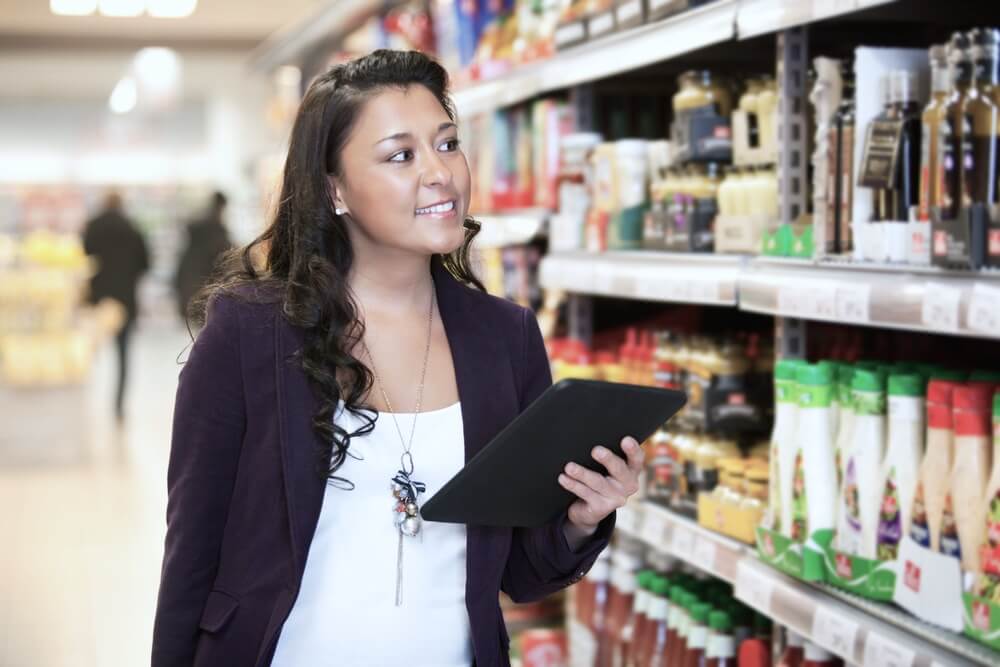Emerging tech is driving growth at leading supermarket chains

Since Amazon’s acquisition of Whole Foods, the grocery industry has been feeling the heat. While analysts say smaller chains will suffer the most, extreme competition is nothing new for the $650 billion U.S. food retail sector. Price wars have been a common survival tactic for years, and as new threats arise, the industry is innovating with technology to stay afloat.
The rise of meal-kit delivery services like Blue Apron, growing pressure from Amazon, and millennials’ preference for dining out are just a few of the shifts impacting grocer’s bottom lines. While small stores are investing in niche experiences such as boosting ready-made offerings to stand out, the big chains are turning to technology to implement sweeping upgrades across the industry. Here’s a look at the major technologies grocers are turning toward to build loyalty, improve customer experience, and drive growth:
Mobile Apps
While older generations may still glance at retail circulars for the latest deals, mobile-savvy consumers are turning to apps like Snap by Groupon, Ibotta, Shopkick Grocery, and others that offer rewards and discounts for engaging with specific brands. Similarly, apps that help organize shopping lists and plan meals, such as Grocery Pal, ListEase, and Grocery iQ, ensure that the fridge and pantry stay stocked. Some chains even have their own apps—Whole Foods, Aldi, and Wegmans, to name a few—to keep consumers returning to their stores.
IoT
When customers walk into a modern store, it’s likely they are unaware of the in-store technologies that are making their experience more frictionless. For example, OpSense is based on a temperature monitoring solution created by our parent company, Mission Data, for Kroger, the largest supermarket chain in the U.S. The technology is installed in the freezers and refrigerated cases throughout its nearly 3,000 stores. The system of water- and humidity-proof IoT sensors monitors the temperature along with data tracking what types of product are in those cases. The platform gives store executives and managers critical data, actionable reporting, and real-time alerts so they can address and remediate potential problems before they happen.
Another IoT solution Mission Data developed for Kroger is EDGE shelving, where shelves feature digital displays that present pricing information, videos about the products, and other information. They can also tell store employees via a mobile app which SKUs should be on the shelves and where they should be presented.
Click and Collect
Nearly a quarter of American households currently buy some groceries online, and that number is ripe for growth. According to a report by Food Marketing Institute and Nielsen, more than 70 percent will engage with online food shopping within 10 years.
Amazon, Boxed, Fresh Direct, and Jet are all making inroads on the grocery trade. Along with the rise of home delivery (Peapod, Instacart), grocery chains like Kroger, Meijer, and The Fresh Market are implementing click-and-collect solutions to stay competitive and meet consumer needs. Customers choose their items online, then receive a notification by phone when their orders are ready. They drive to the store to pick up their purchase without having to go inside the store—it’s simply a matter of driving to a designated area, making the payment, and popping the trunk. One perk of click-and-collect versus home delivery is that customers can make additional purchases once they’re at the store, in the event they have forgotten anything.
Mobile Payments
Numerous leading retailers such as Starbucks, Dunkin Donuts, Panera, and convenience store chain Cumberland Farms are winning over consumers with custom mobile wallet apps. A recent report from Persistence Market Research shows that the consumer mobile payments market is currently worth $870 million, and is expected to balloon to $27.7 billion by 2026. That massive growth trend is prompted by factors such as improved mobile connectivity, increased numbers of vendors accepting mobile payment methods, and customers’ growing acceptance of the security and capability of these systems.
While a number of grocery stores are connecting to Apple Wallet, Google Wallet, PayPal, and other mobile wallets for customers to use as payment, Walmart has rolled out Walmart Pay, allowing shoppers to pay within its existing app. Kroger recently announced it will roll out its “Scan, Bag, Go” solution that allows customers to bag items as they shop, and pay for them via mobile app on their way out.
Big Data
Leading retailers are mining data from loyalty programs to give customers personalized marketing based on past purchases. We’ve all heard the eerie story about Target knowing that a teen girl was pregnant before her father did—but creepy or not, customers are giving retailers access to their shopping behavior on a massive scale.
Grocers can also use data analytics to optimize pricing, inventory management, and even aisle layout. Analytics dashboards help store management understand which products are most price-elastic, how customers react to combo-offers, and whether their promotions performed as planned. From increasing shopper spend per visit to creating successful cross-selling campaigns, actionable intelligence can empower leading grocery retailers to build a competitive edge and grow their market share.
Conclusion
While emerging tech may appear to be a threat to brick-and-mortar, at the end of the day, many shoppers will continue to want to see, smell, and inspect their food before purchasing. Retailers that invest in innovative solutions to redefine the shopping experience, streamline operations, and reduce friction will be best situated to remain competitive as technology trends advance.
Gain Control Today
Achieve operations efficiency and food safety compliance with our simple, intuitive solution.
Learn More